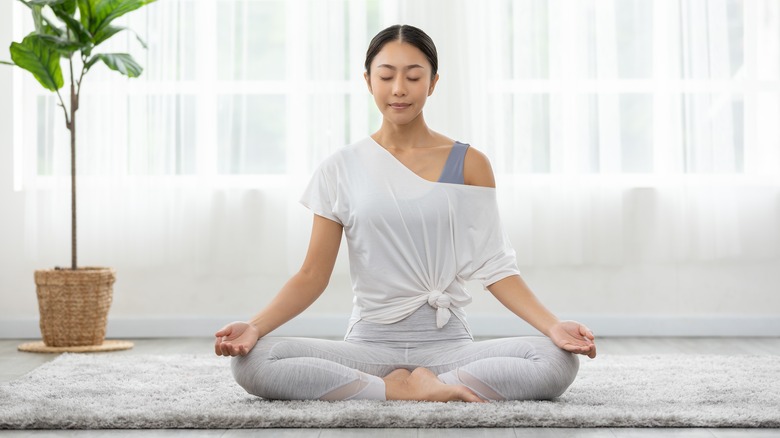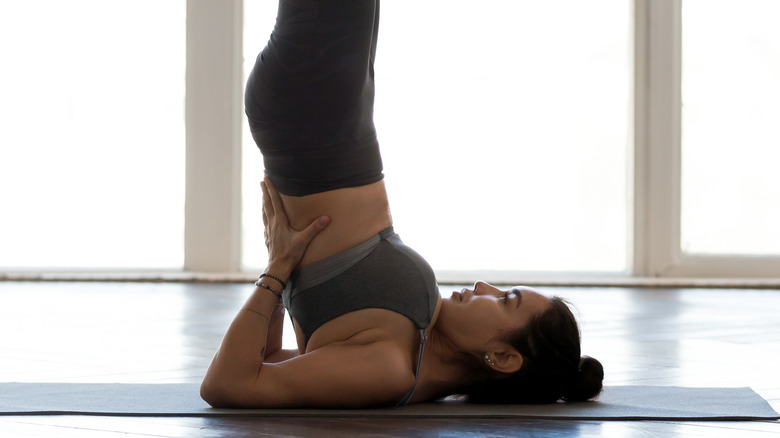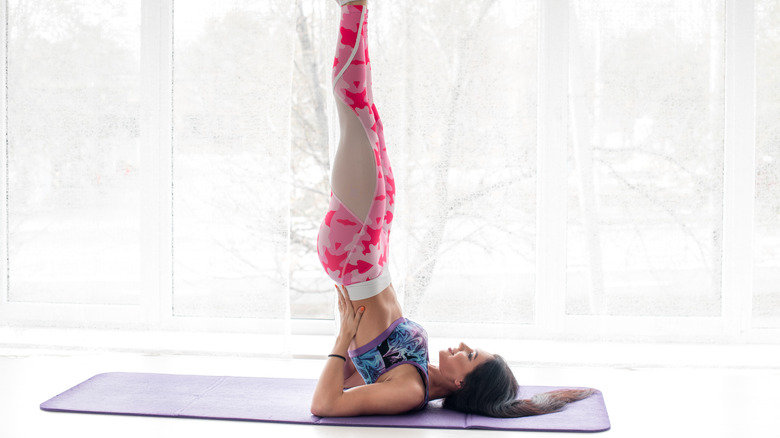The Common Yoga Position That's Actually Hurting You - Exclusive
It's no secret that there are many benefits to practicing yoga on a regular basis. Yoga is a great way to help tone your muscles, improve your balance, enhance your posture and flexibility, and strengthen your core. However, not every yoga pose is associated with the same health and fitness benefits. As a matter of fact, there are some yoga poses that can actually end up doing more harm than good (via Healthline).
Although yoga is often touted as a safer alternative to other types of exercise, experts say that it carries the same risks as running, swimming, weightlifting, and other similar workouts. That's because it can put added stress and pressure on your musculoskeletal system. In an exclusive interview with Health Digest, Lindsay Monal, E-RYT 500, a yoga teacher trainer and curriculum director at YogaRenew Online Yoga Teacher Training, explains how a common yoga position can actually harm your body and lead to injuries.
The most common yoga pose that can cause injuries
The most common yoga position that can increase your risk of injury are known as inversion poses, according to Monal. "In my experience, inversions like shoulder stands are the most common position students get injured from in yoga class," Monal says. "The issue comes in this pose when students put an excessive amount of weight and pressure on the neck, compressing the cervical vertebrae, and potentially leading to injury."
Monal explains that her yoga students often try to use their legs to maintain their balance by kicking them up into the air instead of purposefully lifting them up using core control, which can injure the neck region. It's also not uncommon for students to lose their balance once they're already in position, causing them to roll out of the shoulder stand pose. Monal says that doing this can put added pressure on one of the most sensitive areas of the spine, which can potentially lead to injury.
The greatest risks associated with the shoulder stand pose
Known as the "queen" of yoga poses, the shoulder stand is considered an intermediate or advanced level of yoga posture. Because of this, Monal says that it should only be practiced in the presence of an experience yoga instructor or by students who have a long history of advanced and persistent yoga practice. "It's contraindicated for students with shoulder, neck, or back injuries to practice this posture," Monal shares. "Additionally, students with high blood pressure should use caution when practicing shoulder stand as they can increase one's blood pressure even more."
While there is nothing inherently wrong or dangerous about this pose when done correctly, Monal stresses that the biggest risk lies in performing the shoulder stand the wrong way. That's when the risk of injury really increases. As it turns out, kicking up with your legs to maintain your position or putting too much pressure on your neck can potentially damage your cervical spine.
How to safely and correctly perform a shoulder stand
According to Monal, however, you can try to avoid these risks by learning how to perform a shoulder stand safely and correctly. When performing a shoulder stand yoga pose, it's important to ensure that you do it the right way by maintaining proper form and posture and refraining from moving your body in any way that puts unnecessary stress and pressure on your neck region.
"If you're practicing shoulder stand, you'll want to make sure your weight is evenly distributed between the shoulders and upper arms with little to no weight on the head and neck," Monal explains. You'll also want to make sure that the position of your legs does not cause you to lose your balance and topple over. "Engage your legs so that they are extended straight up and not swaying to one side," Monal adds. "And use your hands on your lower back for support."
Modified poses that stretch the same muscles
If a regular shoulder stand is too advanced or difficult to maintain, you can always try some modified poses that ultimately help stretch the same exact muscle groups. According to Monal, one way you can safely practice a modified shoulder stand is by placing a folded blanket under your shoulders to provide cushion and support.
"If you do this, make sure the blanket is aligned with the short edge of your mat and that your head and neck are not on the blanket — this is to help support and reduce injury to your neck," Monal shares. Believe it or not, you can also perform what is known as a half-shoulder stand by placing a block under your hips and then extending your legs straight up toward the ceiling. "The last, most restorative option would be to lay on the floor and extend your legs up the wall for a more comfortable stretch with similar benefits to shoulder stand," she says.
To learn more about Lindsay Monal, you can find her on Facebook, Instagram, and YouTube, or visit YogaRenew.





